To the Editor:
Dennis Blair and Kenneth Lieberthal's argument that the strength and presence of the U.S. Navy guarantee the safety of the world's commercial sea-lanes ("Smooth Sailing," May/June 2007) ignores a basic reality of the maritime domain: threats and actions at sea cannot be assessed in isolation from the shore. Oil tankers are more vulnerable than the authors acknowledge, and they are vulnerable in more areas of the world than those specified in the article. Furthermore, the supposed resilience of individual ships and the relative weakness of possible adversaries are not enough to ensure the security of global oil supplies.
The authors correctly point out that modern tankers are quite resilient to attacks from modern weapons. However, they ignore the experience of the "tanker war" (1984-88), in which ship after ship effectively became a total loss when struck on the bridge or in the engine room or pump rooms. If the immediate effect of an attack did not stop these ships dead in the water, the understandable but often premature abandonment by their crews often did.
It is not true, as Blair and Lieberthal imply, that the only locations where the potential risks to international tanker traffic are critical are the Strait of Hormuz and the Strait of Malacca and the Strait of Singapore. Other important chokepoints located in areas accessible to potentially hostile forces include the relatively narrow Bab el Mandeb and the Suez Canal. The Bab el Mandeb is the exit point to the east for loaded tankers carrying nearly one million barrels of oil per day from one of the world's most important crude oil terminals, the Saudi port of Yanbu. Additionally, the northern Red Sea anchors one of the most important crude oil discharge ports, Egypt's Ain Sukhna terminal, receiving about 1.5 million barrels per day. Roughly 40 percent of the world's fleet of transoceanic oil tankers passes through the Bab el Mandeb every year. And the Suez Canal is an important route for many of the world's largest tankers, which use it as a shortcut when returning to the Persian Gulf from northern Europe or the Western Hemisphere. Losing access to the Suez Canal would dramatically increase the number of hulls required to maintain the same flow of oil. The number of points of vulnerability along sea routes thus means greater pressure on defensive forces such as the U.S. Navy and the navies of U.S. allies.
Regardless, real threats to the oil supply and energy security do not come from conventional military or asymmetric strikes against ships or chokepoints, as Blair and Lieberthal imply. Rather, the flow of oil is critically vulnerable not at sea but where the shore interfaces with the sea: at oil loading terminals and associated infrastructure. Navies, including many not as large or as powerful as that of the United States, can attack these facilities with dramatic and long-term effects on the energy supply and the price of oil. It could take years to rebuild or replace a terminal such as Ras Tanura, in Saudi Arabia, if it were destroyed. Remove the Juaymah terminal and Yanbu as well, and 20 percent of the world's maritime oil exports would be cut off and access to nearly all of its spare oil production capacity blocked. Oil refineries at both loading and discharge ports are similarly vulnerable, and they are presently the weakest link in the oil supply chain.
Glenn Davis, Charles Dragonette, and Randy Young
